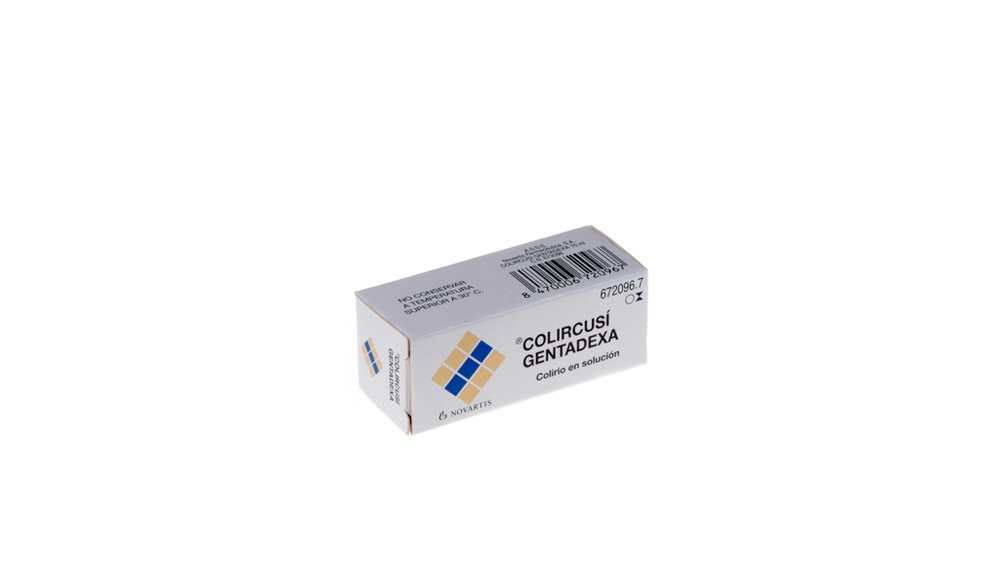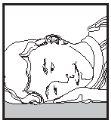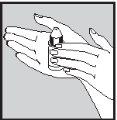

КОЛИРКУСИ ГЕНТАДЕКСА 5 мг/мл + 1 мг/мл + 0,5 мг/мл ГЛАЗНЫЕ/УШНЫЕ КАПЛИ, РАСТВОР

Спросите врача о рецепте на КОЛИРКУСИ ГЕНТАДЕКСА 5 мг/мл + 1 мг/мл + 0,5 мг/мл ГЛАЗНЫЕ/УШНЫЕ КАПЛИ, РАСТВОР

Инструкция по применению КОЛИРКУСИ ГЕНТАДЕКСА 5 мг/мл + 1 мг/мл + 0,5 мг/мл ГЛАЗНЫЕ/УШНЫЕ КАПЛИ, РАСТВОР
Введение
Инструкция: информация для пользователя
КОЛИРКУСИ ГЕНТАДЕКСА 5 мг/мл + 1 мг/мл + 0,5 мг/мл глазные капли/уши в растворе
гентамицин сульфат/дексаметазон фосфат натрия/тетризолин гидрохлорид
Прочитайте внимательно всю инструкцию перед началом использования этого лекарства, поскольку она содержит важную информацию для вас.
- Сохраните эту инструкцию, поскольку вам может потребоваться прочитать ее снова.
- Если у вас есть какие-либо вопросы, проконсультируйтесь с вашим врачом или фармацевтом.
- Это лекарство было назначено только вам, и не передавайте его другим людям, даже если они имеют те же симптомы, что и вы, поскольку оно может нанести им вред.
- Если вы испытываете побочные эффекты, проконсультируйтесь с вашим врачом или фармацевтом, даже если это побочные эффекты, которые не указаны в этой инструкции. См. раздел 4.
Содержание инструкции
- Что такое КОЛИРКУСИ ГЕНТАДЕКСА и для чего оно используется
- Что вам нужно знать перед началом использования КОЛИРКУСИ ГЕНТАДЕКСА
- Как использовать КОЛИРКУСИ ГЕНТАДЕКСА
- Возможные побочные эффекты
- Хранение КОЛИРКУСИ ГЕНТАДЕКСА
- Содержание упаковки и дополнительная информация
1. Что такое КОЛИРКУСИ ГЕНТАДЕКСА и для чего оно используется
Это сочетание методов лечения воспаления и инфекции в глазах и ушах. Оно содержит активные вещества гентамицин, антибиотик, который принадлежит к группе аминогликозидов, используемый для лечения инфекций, дексаметазон, кортикостероид с противовоспалительными и антиаллергическими свойствами, и тетризолин, с сосудосуживающим действием (производит сужение видимых кровеносных сосудов глаза); три компонента, которые работают вместе для лечения инфекции и воспаления.
Одно из активных веществ этого лекарства является антибиотиком. Антибиотики используются для лечения бактериальных инфекций и не подходят для лечения вирусных инфекций.
Важно следовать инструкциям относительно дозы, интервала введения и продолжительности лечения, указанным вашим врачом.
Не храните и не повторно используйте это лекарство. Если после окончания лечения у вас осталось антибиотик, верните его в аптеку для правильной утилизации. Не следует выбрасывать лекарства в канализацию или мусор.
Колиркуси Гентадекса показан для лечения инфекций переднего отдела глаза с воспалительными осложнениями, которые реагируют на кортикостероиды, вызванные микроорганизмами, чувствительными к гентамицину. Такие как конъюнктивит, т.е. инфекция конъюнктивы (прозрачной оболочки, покрывающей глаз) и блефароконъюнктивит (воспаление век) инфекционный и аллергический. Также для лечения кератита, т.е. воспаления роговицы или прозрачной оболочки, покрывающей переднюю часть глаза (поверхностного, глубокого, по определенной реакции гиперчувствительности или фликтенулярного, склерозирующего, розацеа) и для лечения воспаления белого глаза, глубокого (склерит) и поверхностного (эписклерит).
Колиркуси Гентадекса также используется для лечения инфекций ушей (отит) как аллергический отит и во всех случаях, когда требуется лечение кортикостероидами-антибиотиками.
2. Что вам нужно знать перед началом использования КОЛИРКУСИ ГЕНТАДЕКСА
Не используйте КОЛИРКУСИ ГЕНТАДЕКСА
Если вы аллергичны к гентамицину, дексаметазону, тетризолину или связанным с ними продуктам, или к любому другому компоненту этого лекарства (указанному в разделе 6).
Не используйте Колиркуси Гентадекса в ваших глазах:
- Если у вас есть или вы считаете, что можете иметь:
- Глаукому простую.
- Глаукому с узким углом или узким углом в ваших глазах по анатомии (с блокировкой каналов дренажа).
- Оспу, ветрянку или любую другую инфекцию глаза, вызванную вирусом.
- Грибковые заболевания (фунгические) глаза или необработанные инфекции глаза, вызванные паразитами.
- Туберкулез глаза.
- После удаления постороннего предмета из роговицы.
Не используйте Колиркуси Гентадекса в ваших ушах:
- Если у вас есть или вы считаете, что можете иметь:
- Инфекцию в слуховом проходе, вызванную грибами или вирусом, или необработанные инфекции, вызванные паразитами.
- Поврежденную барабанную перепонку или даже перфорированную.
Предостережения и меры предосторожности
Проконсультируйтесь с вашим врачом или фармацевтом перед началом использования Колиркуси Гентадекса.
- Используйте это лекарство только в ваших глазах или ушах.
- Из-за риска возможных системных эффектов будьте особенно осторожны у детей, если у вас есть возраст или тяжелые заболевания сердца, такие как гипертония, атеросклероз, коронарные заболевания, аневризма (бугорок на стенках артерии или вены) или другие сердечно-сосудистые заболевания, или если у вас есть предрасположенность к ним, такие как диабет; если вы часто испытываете падение давления при изменении положения или имеете гиперактивность щитовидной железы, или опухоль надпочечной железы (феохромоцитома).
- Из-за присутствия тетризолина у вас может появиться расширение зрачка, увеличение давления в глазах и системные побочные эффекты вследствие абсорбции. Были зарегистрированы случаи таких эффектов, как головная боль, повышение артериального давления, нарушения сердечного ритма (экстрасистолия), быстрое сердцебиение, головокружение и инсульт. Требуется осторожность в случае применения определенных анестетиков (например, галотана).
- Если вы принимаете ингибиторы моноаминоксидазы (ИМАО) или в течение последних 15 дней, вы можете испытать значительное повышение артериального давления с этим лекарством. Также с другими продуктами, повышающими давление.
- Были обнаружены тяжелые побочные реакции, такие как нейротоксичность, ототоксичность и нефротоксичность с аминогликозидными антибиотиками, используемыми системно (внутренне, например, перорально) или когда они применяются местно на открытых ранах или поврежденной коже.
- Если вы испытываете аллергические реакции с этим лекарством, такие как зуд век, отек или покраснение глаза, прекратите лечение и проконсультируйтесь с вашим врачом. Аллергические реакции могут варьироваться от местного зуда или покраснения до тяжелых аллергических реакций (анафилактическая реакция) или тяжелых кожных реакций. Эти аллергические реакции могут возникать с другими антибиотиками или системными антибиотиками из одной семьи (аминогликозиды).
- Если вы одновременно используете другой антибиотик, проконсультируйтесь с вашим врачом.
- Если ваши симптомы ухудшаются или возвращаются, проконсультируйтесь с вашим врачом. При длительном использовании этого лекарства вы можете стать более чувствительными к инфекциям в глазах или ушах, таким как грибковые инфекции; в случае такой инфекции необходимо прекратить лечение.
Если у вас появляется другая инфекция, ваш врач укажет лечение для ее устранения.
- Если вы используете это лекарство в течение длительного периода в ваших глазах, вы можете:
- Испытать повышение давления в глазу(ах) и/или глаукому. Вам необходимо регулярно контролировать давление в глазах во время использования этого лекарства. Это особенно важно у детей, поскольку риск повышения внутриглазного давления, вызванного кортикостероидами, может быть выше у детей и возникать раньше, чем у взрослых.
- У вас также могут появиться катаракты.
У пациентов с повышенной чувствительностью (например, диабетиков и миопов) риск выше.
- Вам необходимо часто посещать вашего врача, если вы используете это лекарство в течение длительного периода.
- Разработать синдром Кушинга из-за того, что лекарство попадает в кровь. Проконсультируйтесь с вашим врачом, если вы испытываете отек и увеличение веса вокруг туловища и лица, поскольку это, как правило, первые проявления синдрома Кушинга. Может произойти подавление функции надпочечной железы после прекращения интенсивного или длительного лечения Колиркуси Гентадекса. Проконсультируйтесь с вашим врачом перед прекращением лечения по своей инициативе. Эти риски особенно важны у детей и пациентов, леченных ритонавиром или кобисистатом.
- Стероиды, применяемые в глазах, могут задерживать заживление ран. Также известно, что нестероидные противовоспалительные глазные капли (НПВК) замедляют или задерживают процесс заживления. Совместное использование НПВК и стероидных глазных капель может увеличить проблемы с заживлением.
- Если вы страдаете от заболевания, вызывающего истончение тканей глаза до использования этого лекарства, проконсультируйтесь с вашим врачом, поскольку это может привести к перфорации роговицы.
- При длительном использовании этого лекарства вы можете испытать аномальную сухость в глазах, которая может ухудшить симптомы аллергического конъюнктивита.
- Свяжитесь с вашим врачом, если у вас出现ится размытое зрение или другие нарушения зрения.
- Если вы используете контактные линзы:
- Носить контактные линзы (жесткие или мягкие) не рекомендуется во время лечения воспаления или инфекции глаза.
Ушная форма
В случае использования в ушах (ушной форме) ваш врач должен проверить состояние вашей барабанной перепонки.
Дети
Не используйте Колиркуси Гентадекса у детей младше 18 лет, поскольку его безопасность и эффективность не установлены.
Пациенты пожилого возраста
Безопасность и эффективность этого лекарства у пациентов пожилого возраста не установлены.
Другие лекарства и Колиркуси Гентадекса
Сообщите вашему врачу или фармацевту, если вы используете, недавно использовали или можете использовать любое другое лекарство.
Сообщите вашему врачу, если вы используете нестероидные противовоспалительные глазные капли. Совместное использование кортикостероидов и нестероидных противовоспалительных глазных капель может увеличить проблемы с заживлением роговицы.
Особенно сообщите вашему врачу, если вы принимаете ингибиторы моноаминоксидазы (ИМАО).
Сообщите вашему врачу, если вы используете ритонавир или кобисистат, поскольку это может привести к увеличению количества дексаметазона в крови.
Беременность, лактация и фертильность
Если вы беременны или в период лактации, считаете, что можете быть беременной или планируете стать беременной, проконсультируйтесь с вашим врачом или фармацевтом перед использованием этого лекарства.
Колиркуси Гентадекса не рекомендуется во время беременности.
Если вы в период лактации, ваш врач должен решить, необходимо ли прекратить лактацию или прекратить лечение этим лекарством, учитывая пользу лактации для ребенка и пользу лечения для матери.
Вождение и использование машин
Использование в глазах:Вы можете заметить размытое зрение сразу после применения Колиркуси Гентадекса в течение некоторого времени. Не驾驶айте транспорт и не используйте машины до тех пор, пока этот эффект не пройдет.
Использование в ушах:Не ожидайте эффектов на вождение или использование машин.
Колиркуси Гентадекса содержит бензалконий хлорид и фосфаты
Это лекарство содержит 0,04 мг бензалкония хлорида в каждом мл.
Использование в глазах:Бензалконий хлорид может быть абсорбирован мягкими контактными линзами, изменяя их цвет. Удалите контактные линзы перед использованием этого лекарства и подождите 15 минут перед повторным их применением.
Бензалконий хлорид может вызвать раздражение глаз, особенно если у вас сухой глаз или другие заболевания роговицы (прозрачной оболочки передней части глаза). Проконсультируйтесь с вашим врачом, если вы чувствуете странное ощущение, зуд или боль в глазу после использования этого лекарства.
Это лекарство содержит 1,8 мг фосфата в каждом мл.
Если у вас есть тяжелое повреждение роговицы (прозрачной оболочки передней части глаза), лечение фосфатами в редких случаях может привести к размытому зрению из-за накопления кальция.
Использование в ушах:Бензалконий хлорид может вызвать раздражение кожи. Не наносите на слизистую.
3. Как использовать КОЛИРКУСИ ГЕНТАДЕКСА
Следуйте точно инструкциям по введению этого лекарства, указанным вашим врачом. В случае сомнений проконсультируйтесь с вашим врачом или фармацевтом.
Колиркуси Гентадекса может быть использовано как глазные капли для глаз (глазная форма) и капли для ушей (ушная форма).
Как использовать в глазу (глазная форма)
Рекомендуемая доза:
Взрослые: 1 или 2 капли в глаз(ах), пораженном(ых), каждые 4 или 5 часов (при тяжелых инфекциях частота закапывания может быть увеличена). Частота может быть снижена по указанию вашего врача.
Лечение должно быть постепенно снижено, снижая частоту введения.
Лечение не должно превышать 14 дней, если не указано иное вашим врачом.
Рекомендации по использованию

1 2 3
- Вымойте руки.
- Возьмите флакон (капельницу).
- После открытия флакона в первый раз удалите пластиковое кольцо с упаковки, если оно свободно.
- Держите флакон, повернутый вниз, между пальцами.
- Наклоните голову назад. Аккуратно отодвиньте веко глаза, чтобы между веком и глазом образовалась полость, в которую должна попасть капля (рисунок 1).
- Поднесите носик флакона к глазу. Вам может быть полезен зеркало.
- Не касайтесь глаза или век, близлежащих зон или других поверхностей капельницей. Капли могут быть загрязнены.
- Аккуратно нажмите на основание флакона указательным пальцем, чтобы выпустить одну каплю за раз (рисунок 2).
- После использования глазных капель отпустите веко, закройте глаз и аккуратно нажмите на край глаза у носа не менее 2 минут. Это помогает предотвратить попадание этого лекарства в другие части тела (рисунок 3).
- Если вы капаете капли в оба глаза, повторите все предыдущие шаги для другого глаза.
- Закройте флакон плотно сразу после использования продукта.
Если капля попадает вне глаза, попробуйте снова.
Если симптомы не улучшаются в течение 2 дней, проконсультируйтесь с вашим врачом.
Если вы используете больше Колиркуси Гентадекса, чем необходимо, вы можете удалить его, промыв глаза теплой водой. Не наносите больше капель, пока не придет время следующей дозы.
Если вы используете другие глазные лекарства, подождите не менее 5 минут между введением этого колирого раствора и других глазных лекарств. Глазные мази должны быть нанесены в последнюю очередь.
Как использовать в ухе
Рекомендуемая доза:
Взрослые: 3 или 4 капли в ухо(ах), пораженном(ых), 3 раза в день.
Лечение не должно превышать 14 дней.
Рекомендации по использованию



1 2 3
- Вымойте руки
- Возьмите флакон (капельницу) и держите его несколько минут в руке, чтобы согреть содержимое и избежать слишком холодной капли, когда она попадет в ухо (рисунок 1).
- Держите флакон, повернутый вниз, между пальцами.
- Лягте на бок, повернув пораженное ухо вверх.
- Поднесите носик флакона к слуховому проходу (рисунок 2).
- Не касайтесь мочки уха, слухового прохода или близлежащих зон или других поверхностей капельницей. Капли могут быть загрязнены.
- Дайте капле этого лекарства попасть в ухо, аккуратно нажимая на основание флакона указательным пальцем.
- Оставайтесь лежать не менее 5 минут, чтобы позволить ушным каплям проникнуть в слуховой проход (рисунок 3).
- Если вы капаете капли в оба уха, повторите предыдущие шаги для другого уха.
- Закройте флакон плотно сразу после использования продукта.
Если капля попадает вне уха, попробуйте снова.
Если вы используете больше КОЛИРКУСИ ГЕНТАДЕКСА, чем необходимо
Не наносите больше капель, пока не придет время следующей дозы.
Передозировка в глазах может быть удалена, промыв глаза теплой водой.
Могут возникнуть (особенно у детей) тяжелые реакции, такие как симптомы депрессии центральной нервной системы и тяжелые реакции, влияющие на сердце и кровообращение; среди других симптомов, понижение температуры тела, замедление сердечного ритма, потливость, обморок и цереброваскулярные происшествия. Может произойти подавление функции надпочечной железы после прекращения интенсивного или длительного лечения Колиркуси Гентадекса.
Другие симптомы, которые могут возникнуть при случайном приеме лекарства, особенно у детей, являются: сердечные перебои, нерегулярный сердечный ритм, головная боль, головокружение, тошнота, рвота, расширение зрачков, затруднение дыхания и другие.
В случае передозировки или случайного приема проконсультируйтесь немедленно с вашим врачом или фармацевтом, или обратитесь в медицинский центр или позвоните в Токсикологическую службу, телефон 91 562 04 20, указав лекарство и количество, использованное.
Если вы забыли использовать КОЛИРКУСИ ГЕНТАДЕКСА
Не наносите двойную дозу, чтобы компенсировать пропущенную дозу.
Нанесите одну дозу как можно скорее, и продолжайте с следующей дозой, запланированной в вашем режиме.
Если у вас есть другие вопросы об использовании этого лекарства, проконсультируйтесь с вашим врачом или фармацевтом.
4. Возможные побочные эффекты
Как и все лекарства, это лекарство может вызывать побочные эффекты, хотя не все люди их испытывают.
Были обнаружены следующие побочные эффекты при использовании этого лекарства для глаз.
Частота неизвестна (не может быть оценена на основе доступных данных)):
- Эффекты на глаза: раздражение глаз, боль в глазах (включая жжение), местная аллергия, размытое зрение.
- Общие побочные эффекты: аллергия (гиперчувствительность).
- Гормональные проблемы: чрезмерный рост волос на теле (особенно у женщин), слабость и истощение мышц, фиолетовые полосы на коже тела, повышение артериального давления, нерегулярные или отсутствующие менструации, изменения в уровнях белков и кальция в организме, задержка роста у детей и подростков, а также отек и увеличение веса тела и лица (синдром Кушинга) (см. раздел 2, "Предупреждения и меры предосторожности").
Были сообщения о редких случаях кальцификации роговицы при использовании глазных капель, содержащих фосфаты, у пациентов с серьезно пораженной роговицей.
Описание выбранных побочных эффектов
Использование в глазах:
Продолжительное использование глазных кортикостероидов может привести к повышению внутриглазного давления и/или глаукоме, что может вызвать повреждение зрительного нерва, влияя на остроту зрения и периферическое зрение; также может привести к катаракте. И может появиться задержка в заживлении роговицы.
Кортикостероид (дексаметазон) может вызывать головокружение, головную боль, воспаление роговицы, конъюнктивит, сухость глаз, окрашивание роговицы, чувствительность к солнечному свету (фотофобия), размытое зрение, зуд в глазах, ощущение инородного тела, увеличение слезотечения, корочка на краю века, покраснение глаз, эрозия роговицы, расширение зрачка.
У пациентов с заболеваниями, вызывающими истончение роговицы или склеры, местное применение кортикостероидов может привести к перфорации роговицы, более вероятной при длительном лечении.
Были зарегистрированы вторичные инфекции после совместного использования кортикостероидных и антибактериальных препаратов (например, гентамицина).
Из-за присутствия тетризолина в составе может появиться, кроме других побочных эффектов, воспаление век (блефарит), системные побочные эффекты (в внутренних частях тела) в результате абсорбции, которые, кажется, более часты у детей и пожилых людей. Была зарегистрирована системная токсичность при местном применении симпатомиметических препаратов, таких как тетризолин, таких как головная боль, повышение артериального давления, потливость, нарушения сердечного ритма (экстрасистолия), учащенное сердцебиение, обморок и цереброваскулярные происшествия.
Другие побочные реакции, зарегистрированные при использовании глазных капель, включают дефекты эпителия в конъюнктиве и покраснение конъюнктивы, конъюнктивит с образованием псевдомембран.
Использование в ушах:
Хотя это редко, пациенты, которым требуется длительное использование антибиотиков аминогликозидов через ушные капли для лечения хронического среднего отита, испытывали потерю слуха, которая может повлиять на внутреннее ухо и слуховой нерв (нейросенсорный).
Другие побочные эффекты при использовании ушных капель включают акне при длительном применении, задержку заживления и раздражение кожи.
Дополнительные побочные эффекты у детей
Чрезмерное использование этого лекарства у детей может привести к серьезным реакциям, таким как снижение температуры тела, обморок или другие симптомы депрессии центральной нервной системы.
Сообщение о побочных эффектах
Если вы испытываете любой побочный эффект, проконсультируйтесь с вашим врачом или фармацевтом, даже если это возможные побочные эффекты, которые не указаны в этом описании. Вы также можете сообщить о них напрямую через Испанскую систему фармаковигиланса лекарственных средств для человека: https://www.notificaRAM.es.Сообщая о побочных эффектах, вы можете внести свой вклад в предоставление более подробной информации о безопасности этого лекарства.
5. Хранение COLIRCUSÍ GENTADEXA
Храните это лекарство в недоступном для детей месте.
Не храните при температуре выше 30 °C.
Не используйте это лекарство после даты истечения срока годности, указанной на флаконе и упаковке после CAD. Дата истечения срока годности - последний день месяца, указанного.
Чтобы избежать инфекций, необходимо утилизировать флакон через 4 недели после первого открытия.
Запишите дату открытия флакона в отведенном для этого месте на упаковке.
Лекарства не должны выбрасываться в канализацию или мусор. Поместите упаковку и лекарства, которые вам больше не нужны, в пункт SIGRE аптеки. Если у вас есть сомнения, спросите у вашего фармацевта, как утилизировать упаковку и лекарства, которые вам больше не нужны. Таким образом, вы поможете защитить окружающую среду.
6. Содержимое упаковки и дополнительная информация
Состав Colircusí Gentadexa
- Активные вещества - гентамицин, дексаметазон фосфат натрия и тетризолин гидрохлорид. 1 мл раствора содержит 5 мг гентамицина сульфата (0,5%) (что соответствует 3 мг/мл гентамицина), 1 мг дексаметазона фосфата натрия (0,1%) и 0,5 мг тетризолина гидрохлорида (0,05%).
- Другие компоненты: бензалконий хлорид, дигидрофосфат динатрия додекагидрат, хлорид натрия, повидон и очищенная вода / вода для инъекций.
Внешний вид продукта и содержимое упаковки
Colircusí Gentadexa - глазные капли (для использования в глазах) или ушные капли (для использования в ушах) в растворе; это прозрачная, бесцветная или слегка желтоватая жидкость.
Продается в капельнице (пластиковый флакон с резьбой), содержащей 10 мл раствора.
Владелец разрешения на маркетинг
NTC s.r.l., via Luigi Razza, 3, 20124 Милан, Италия
Производитель
SIEGFRIED El Masnou, S.A.
C/ Camil Fabra, 58
08320 El Masnou – Барселона,
Испания
Или
EXCELVISION S.A.
27, Rue de la Lombardière
07100 Анноне
Франция
Вы можете запросить дополнительную информацию о этом лекарстве, обратившись к местному представителю владельца разрешения на маркетинг:
NTC Ophthalmics Iberica S.L., Calle Pinar, 5, 28006 Мадрид, Испания
Дата последнего обновления этого описания:Январь 2019
Подробная информация о этом лекарстве доступна на сайте Испанского агентства по лекарствам и медицинским изделиям (AEMPS) http://www.aemps.gob.es/

Сколько стоит КОЛИРКУСИ ГЕНТАДЕКСА 5 мг/мл + 1 мг/мл + 0,5 мг/мл ГЛАЗНЫЕ/УШНЫЕ КАПЛИ, РАСТВОР в Испании в 2025 году?
Средняя цена на КОЛИРКУСИ ГЕНТАДЕКСА 5 мг/мл + 1 мг/мл + 0,5 мг/мл ГЛАЗНЫЕ/УШНЫЕ КАПЛИ, РАСТВОР в ноябрь, 2025 года составляет около 4.45 евро. Финальная стоимость может зависеть от региона, конкретной аптеки и рецептурного статуса. Для точной информации лучше проверить онлайн или в ближайшей аптеке.
- Страна регистрации
- Средняя цена в аптеках4.45 EUR
- Наличие в аптекахПроблемы с поставками
- Активное вещество
- Требуется рецептДа
- Производитель
- Информация носит справочный характер и не является медицинской рекомендацией. Перед приемом любых препаратов проконсультируйтесь с врачом. Oladoctor не несет ответственности за медицинские решения, принятые на основе этого контента.
Врачи онлайн по КОЛИРКУСИ ГЕНТАДЕКСА 5 мг/мл + 1 мг/мл + 0,5 мг/мл ГЛАЗНЫЕ/УШНЫЕ КАПЛИ, РАСТВОР
Консультация по дозировке, побочным эффектам, взаимодействиям, противопоказаниям и продлению рецепта на КОЛИРКУСИ ГЕНТАДЕКСА 5 мг/мл + 1 мг/мл + 0,5 мг/мл ГЛАЗНЫЕ/УШНЫЕ КАПЛИ, РАСТВОР – по решению врача и с учетом местных правил.







